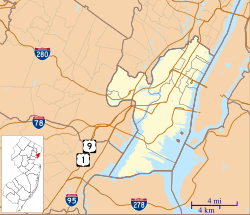Hoboken Land and Improvement Company Building | |
 | |
| Location | 1 Newark Street, Hoboken, New Jersey |
|---|---|
| Coordinates | 40°44′10″N74°1′44″W / 40.73611°N 74.02889°W |
| Area | 0.4 acres (0.16 ha) |
| Built | 1889 |
| Architect | Charles Fall |
| NRHP reference No. | 79001491 [1] |
| NJRHP No. | 1470 [2] |
| Significant dates | |
| Added to NRHP | July 3, 1979 |
| Designated NJRHP | March 29, 1979 |
The Hoboken Land and Improvement Company Building, is located in Hoboken, Hudson County, New Jersey, United States. The building was designed by Charles Fall and was built by Myles Tierney in 1889. The building was added to the National Register of Historic Places on July 3, 1979. The building housed the offices of the Stevens family real estate holding corporation the Hoboken Land and Improvement Company. [3] The building is notable for its high quality brickwork, with recessed panels and contrasting color mortars. [4]


